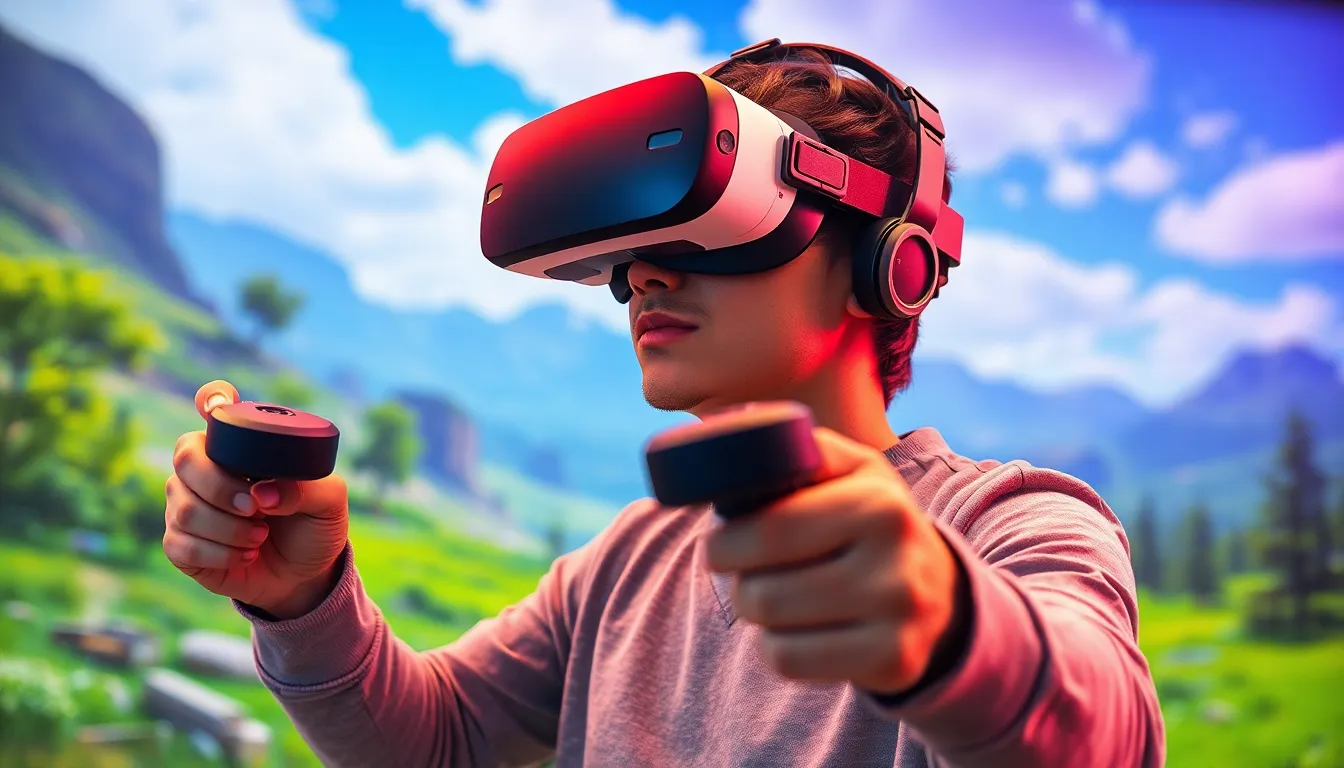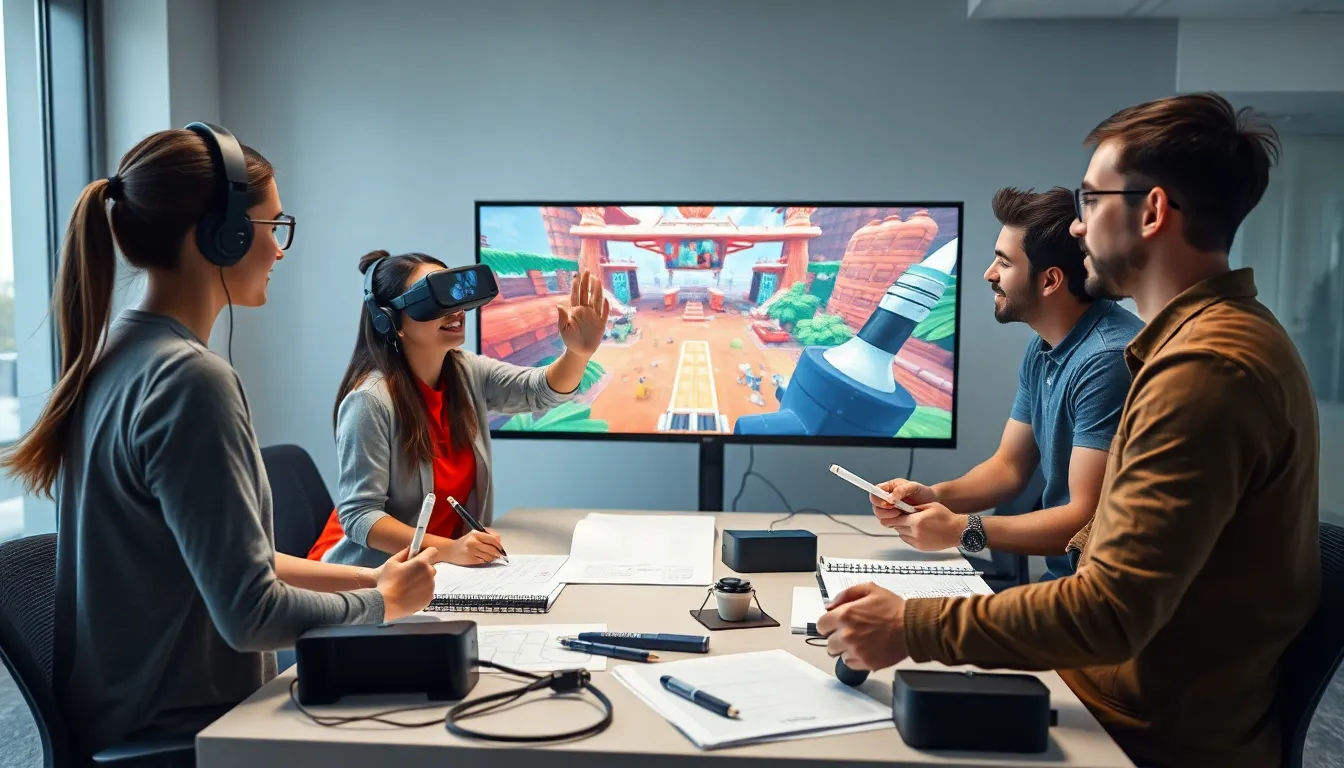In a world where reality sometimes feels a bit too real, virtual reality game development swoops in like a superhero with a cape made of pixels. Developers are crafting immersive experiences that transport players to fantastical realms, where they can slay dragons, explore alien planets, or even dodge flying rubber chickens. Who wouldn’t want to escape the mundane and dive into a universe where the only limit is imagination?
But let’s face it—creating these virtual worlds isn’t just child’s play. It requires a unique blend of creativity, technical know-how, and a sprinkle of madness. As VR technology continues to evolve, game developers are challenged to push boundaries and redefine what gaming can be. Buckle up as we explore the exciting landscape of virtual reality game development, where innovation meets fun, and the only thing more thrilling than the gameplay is the journey behind the scenes.
Table of Contents
ToggleOverview of Virtual Reality Game Development
Virtual reality game development involves creating engaging environments that immerse players in alternate realities. This process merges game design principles with cutting-edge technology to craft experiences that captivate users.
Designers begin by conceptualizing the game world, focusing on narrative, gameplay mechanics, and visual aesthetics. Collaboration between artists, programmers, and sound engineers results in cohesive virtual experiences. Each component, from 3D modeling to audio effects, contributes to immersion.
Developers utilize specialized software such as Unity and Unreal Engine to build VR games. These platforms offer tools for creating interactive elements and realistic graphics. Advanced physics engines enhance player interactivity, making virtual environments feel tangible.
Testing remains vital in VR game development. Iterative processes allow teams to refine gameplay and ensure player comfort. Feedback from playtesters identifies issues like motion sickness, which developers address to enhance user experience.
Trends in virtual reality constantly evolve, driven by technological advancements. Emerging hardware such as standalone headsets expands accessibility. Additionally, innovations like haptic feedback provide deeper sensory experiences, intensifying engagement in gameplay.
Adapting to market demands often guides development choices. Multiplayer capabilities and social interaction feature prominently in many contemporary VR titles. These elements foster community engagement, encouraging players to share experiences and foster connections.
Overall, virtual reality game development encompasses a dynamic blend of creativity and technology. As the industry progresses, developers continuously explore new possibilities, redefining entertainment.
Key Technologies in Virtual Reality

Key technologies power the experience of virtual reality game development. These include hardware components and software platforms which both play crucial roles.
Hardware Components
Head-mounted displays (HMDs) serve as the primary interface for players experiencing VR. These devices provide immersive visuals and track head movements, enhancing realism. Motion controllers enable intuitive interactions, allowing players to manipulate their virtual environments. Additionally, sensors track user movements, ensuring accurate spatial awareness within the game world. High-performance computers or gaming consoles deliver the necessary processing power to run VR applications smoothly, ensuring a seamless experience. Standalone headsets also increase accessibility, eliminating the need for external devices while maintaining rich graphics.
Software Platforms
Unity and Unreal Engine dominate software platforms used in VR development. Both engines support photorealistic graphics and advanced physics, making them popular choices among developers. Unity offers a user-friendly interface and a vast library of assets, expediting the game-building process. Unreal Engine, known for its stunning visuals, excels in environments requiring intricate detail. Furthermore, game developers often leverage specialized SDKs such as Oculus SDK and SteamVR, which provide tools for optimizing compatibility with various headsets. These platforms streamline the development process while enhancing the overall gameplay experience.
Game Design Principles for Virtual Reality
Developing for virtual reality involves unique game design principles that enhance user experiences and create immersive environments. Designers prioritize aspects like immersion and interaction to engage players fully.
Immersion and User Experience
Immersion remains critical in VR. Designers craft realistic environments that captivate players, integrating vivid visuals and spatial audio. Realistic physics contribute significantly to the sense of presence, making actions feel tangible. Feedback mechanisms, such as haptic responses, reinforce interactions by making players feel connected to the virtual world. Additionally, thoughtful use of narrative elements enriches the user’s emotional engagement, enhancing the overall experience.
Interaction Mechanics
Interaction mechanics define how players engage within VR environments. Important elements include natural gestures and intuitiveness in controls. Designers implement motion tracking and hand controllers to enable seamless interactions, enhancing user satisfaction. Providing clear visual cues helps players understand their actions and intentions, improving usability. Offering varied gameplay mechanics encourages exploration and allows players to experiment freely, widening their engagement with the virtual space.
Challenges in Virtual Reality Game Development
Virtual reality game development faces several challenges that impact the creation of immersive experiences. The complexity of VR technology often requires significant resources and expertise.
Technical Limitations
Technical limitations pose substantial hurdles for developers. Hardware constraints, such as processing power and graphics capabilities, can restrict the richness of virtual environments. Developers must ensure compatibility across various headsets and platforms, adding complexity to the design process. Latency issues can disrupt the seamlessness of gameplay, leading to player discomfort. Creating intuitive interactions within VR also demands advanced tracking and input systems, which can vary widely in effectiveness. Addressing these technical barriers remains essential for crafting engaging and accessible VR experiences.
Market Trends and Competition
Market trends continuously evolve in virtual reality, intensifying competition among developers. As consumer demand grows for innovative VR experiences, studios face pressure to differentiate their products. New technologies, such as standalone headsets and mixed reality solutions, emerge frequently, challenging traditional approaches. Additionally, the rise of multiplayer modes has transformed user engagement, compelling developers to incorporate social features into their titles. Understanding market demands and consumer preferences remains critical for developers seeking success in this dynamic landscape.
Future of Virtual Reality Game Development
Emerging trends in virtual reality game development shape the future of interactive entertainment. Integration of artificial intelligence enhances player experiences by facilitating dynamic NPC behavior and adaptive storylines. Analysts predict an increase in cross-platform compatibility, allowing gamers to engage regardless of their chosen hardware.
Advancements in haptic feedback technology deepen user immersion. Realistic sensations improve emotional connections, drawing players further into virtual worlds. Upcoming developments look towards lighter headsets and improved wireless capabilities, making VR more accessible without compromising performance.
Sustainability plays a role in future VR production. Developers are exploring eco-friendly materials for hardware components, responding to growing environmental concerns in tech industries. Incorporating lower energy consumption in both gameplay and hardware design remains a priority.
Social interaction will continue to evolve in VR environments. Multiplayer experiences are becoming richer, with innovative ways for players to collaborate and compete. As users increasingly seek social connections through gaming, developers must focus on creating engaging community features.
Looking further ahead, VR’s impact on other sectors becomes more pronounced. Applications extend beyond gaming to education, healthcare, and training simulations. Potential for VR to revolutionize various fields supports ongoing investment in the technology’s development.
Investment in VR projects grows as companies recognize the market potential. Major gaming studios and independent developers alike are fueling creativity and competition. Forward-thinking approaches will define how the industry adapts to changing consumer preferences and technological advancements.
The future of virtual reality game development is bright and full of possibilities. As technology continues to evolve developers are poised to create even more immersive and engaging experiences. The integration of AI and advancements in haptic feedback will redefine how players interact with virtual worlds.
With a growing focus on sustainability and social interaction developers will need to adapt to meet the demands of an ever-changing market. As VR expands beyond gaming into sectors like education and healthcare the potential for innovation is limitless.
This dynamic landscape invites creativity and collaboration ensuring that the journey of virtual reality game development remains as exciting as the experiences it offers.




